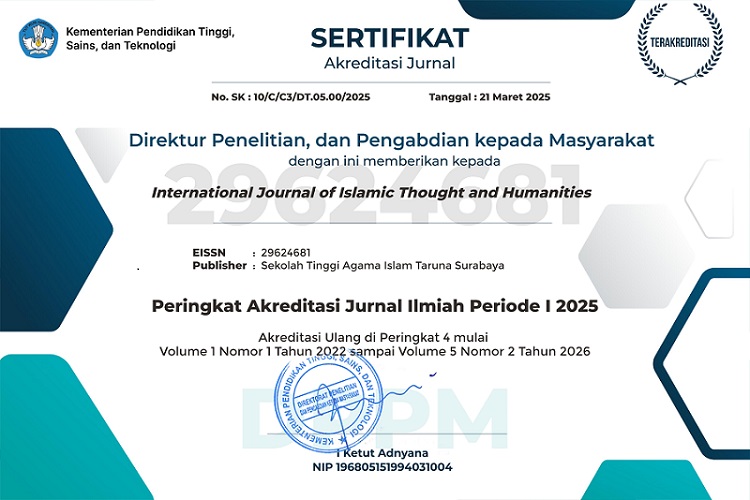Women’s Political Rights Context in Gender and Human Rights Perspective
DOI:
https://doi.org/10.54298/ijith.v1i1.15Keywords:
Women, Politic, GenderAbstract
Women have the right and the potential to make a real contribution to politics. However, the phenomenon of the increasing number of female figures in political contestation in the regions is still the pros and cons. Hence, the involvement of women still invites discussion, and debate, and often leaves doubts. Currently, the representation of women in the legislature is an essential concern of the government, one of which is through an affirmative action policy. In the political context, this affirmative action encouraged women's representation in the legislature. So that a regulation is needed that can guarantee and ensure the representation of women in parliament, both nationally and regionally. Starting with the ratification of the Convention on the Elimination of All Forms Of Discrimination Against Women (CEDAW) by Indonesia in 1984 through Law Number 7 of 1984 which provides special treatment to achieve gender equality, it has also been carried out through several other national laws and regulations, such as Law no. 12 of 2003 which regulates the political parties participating in the election to pay attention to the representation of women at least 30% in the nomination of members of the legislature.
Downloads
References
Bangun, W. (2018). Gender inequality: Concept and measurement (A Study of Indonesia on ASEAN). International Journal of Engineering and Technology(UAE), 7(4). https://doi.org/10.14419/ijet.v7i4.28.22594
Bhalotra, S. R., Clarke, D., Gomes, J., & Venkataramani, A. (2021). Maternal Mortality and Women’s Political Participation. SSRN Electronic Journal. https://doi.org/10.2139/ssrn.3205877
Dahlan, D. (2021). THE POSITION OF WOMAN’S POLITICAL RIGHTS IN ISLAM AND THE INDONESIAN CONSTITUTION. Alfuad: Jurnal Sosial Keagamaan, 5(2). https://doi.org/10.31958/jsk.v5i2.2884
Engida, Y. M. (2021). The Three Dimensional Role of Education for Women Empowerment. Journal of Social Sciences, 17(1). https://doi.org/10.3844/jssp.2021.32.38
Fazaeli, R., & Hanisek, J. (2021). Human rights, islam, and debates around cedaw. Religion and Human Rights, 16(2–3). https://doi.org/10.1163/18710328-bja10020
Hosen, N. (2007). Human rights provisions in the second amendment to the Indonesian constitution from Sharīah perspective. Muslim World, 97(2). https://doi.org/10.1111/j.1478-1913.2007.00171.x
Jaya, M. (2021). PENAFSIRAN SURAT AN-NISA’ AYAT 34 TENTANG KEPIMPINAN DALAM AL-QURAN. At-Tanzir: Jurnal Ilmiah Prodi Komunikasi Penyiaran Islam. https://doi.org/10.47498/tanzir.v11i2.407
Joseph, S. (2022). International Covenant on Civil and Political Rights (ICCPR). In Elgar Encyclopedia of Human Rights. https://doi.org/10.4337/9781789903621.int.covenant.civil
Kamaruddin, Z., & Oseni, U. A. (2013). Between Ideals and Reality: Violence against Women and the Real Image of Women in Islam. The Journal of Oriental Studies, 23(1).
Lay, C. (2017). Political linkages between CSOs and parliament in Indonesia: a case study of political linkages in drafting the Aceh Governance Law. Asian Journal of Political Science, 25(1). https://doi.org/10.1080/02185377.2017.1297243
Mullins, L. B. (2018). CEDAW: The Challenges of Enshrining Women’s Equality in International Law. Public Integrity, 20(3). https://doi.org/10.1080/10999922.2017.1381542
Norzulaili Mohd Ghazali, Adawiyah@usim.edu.my, Mohd Zohdi Mohd Amin, & Nadzrah Ahmad. (2020). An Analysis of Sisters in Islam’s (SIS) Misinterpretation of the Gender Equality in the Quran. Maʿālim Al-Qurʾān Wa Al-Sunnah, 16(2). https://doi.org/10.33102/jmqs.v16i2.231
O’Brien, D. Z., & Piscopo, J. M. (2019). The Impact of Women in Parliament. In The Palgrave Handbook of Women’s Political Rights. https://doi.org/10.1057/978-1-137-59074-9_4
Suhra, S. (2019). POTRET PEREMPUAN DALAMRANAH POLITIK DI INDONESIA. AN-NISA, 11(1). https://doi.org/10.30863/an.v11i1.300
Tait, C. A., Abdillahi, I., Wong, W., Smith-Cannoy, H., & Siddiqi, A. (2019). Can the health effects of widely-held societal norms be evaluated? An analysis of the United Nations convention on the elimination of all forms of discrimination against women (UN-CEDAW). BMC Public Health, 19(1). https://doi.org/10.1186/s12889-019-6607-6
UN General Assembly. (1948). Universal Declaration of Human Rights | United Nations. In General Assembly resolution.
Downloads
Published
How to Cite
Issue
Section
License
Copyright (c) 2022 Diah Ratri Oktavriana

This work is licensed under a Creative Commons Attribution-ShareAlike 4.0 International License.
Authors who publish with this journal agree to the following terms:
- Authors retain copyright and grant the journal right of first publication with the work simultaneously licensed under a Creative Commons Attribution-ShareAlike 4.0 that allows others to share the work with an acknowledgement of the work's authorship and initial publication in this journal.
- Authors are able to enter into separate, additional contractual arrangements for the non-exclusive distribution of the journal's published version of the work (e.g., post it to an institutional repository or publish it in a book), with an acknowledgement of its initial publication in this journal.
- Authors are permitted and encouraged to post their work online (e.g., in institutional repositories or on their website) prior to and during the submission process, as it can lead to productive exchanges, as well as earlier and greater citation of published work (See The Effect of Open Access).


















